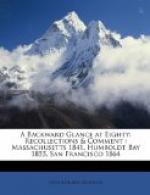On the 15th the diary records: “Last night about 12 o’clock I woke, and who should I behold, standing by me, but my father! Is it possible that after a separation of nearly six years I have at last met my father? It is even so. This form above me is, indeed, my father’s.” The day’s entry concludes: “I have really enjoyed myself today. I like the idea of a father very well.”
We were compelled to await an upcoast steamer till August, when that adventurous craft, the steamer “McKim,” now newly named the “Humboldt,” resumed sea-voyages. The Pacific does not uniformly justify the name, but this time it completely succeeded. The ocean was as smooth as the deadest mill-pond—not a breath of wind or a ripple of the placid surface. Treacherous Humboldt Bar, sometimes a mountain of danger, did not even disclose its location. The tar from the ancient seams of the Humboldt’s decks responded to the glowing sun until pacing the deck was impossible, but sea-sickness was no less so. We lazily steamed into the beautiful harbor, up past Eureka, her streets still occupied by stumps, and on to the ambitious pier stretching nearly two miles from Uniontown to deep water.
And now that the surroundings may be better understood, let me digress from the story of my boyhood and touch on the early romance of Humboldt Bay—its discovery and settlement.
CHAPTER II
A HIDDEN HARBOR
The northwesterly corner of California is a region apart. In its physical characteristics and in its history it has little in common with the rest of the state. With no glamour of Spanish occupancy, its romance is of quite another type. At the time of the discovery of gold in California the northwestern portion of the state was almost unknown territory. For seven hundred miles, from Fort Ross to the mouth of the Columbia, there stretched a practically uncharted coast. A few headlands were designated on the imperfect map and a few streams were poorly sketched in, but the great domain had simply been approached from the sea and its characteristics were mostly a matter of conjecture. So far as is known, not a white man lived in all California west of the Coast Range and north of Fort Ross.
Here is, generally speaking, a mountainous region heavily timbered along the coast, diversified with river valleys and rolling hills. A marked peculiarity is its sharp slope toward the northwest for its entire length. East of the Coast Range the Sacramento River flows due south, while to the west of the broken mountains all the streams flow northwesterly—more northerly than westerly. Eel River flows about 130 miles northerly and, say, forty miles westerly. The same course is taken by the Mattole, the Mad, and the Trinity rivers. The watershed of this corner to the northwest is extensive, including a good part of what are now Mendocino, Trinity, Siskiyou, Humboldt, and Del Norte counties. The drainage




